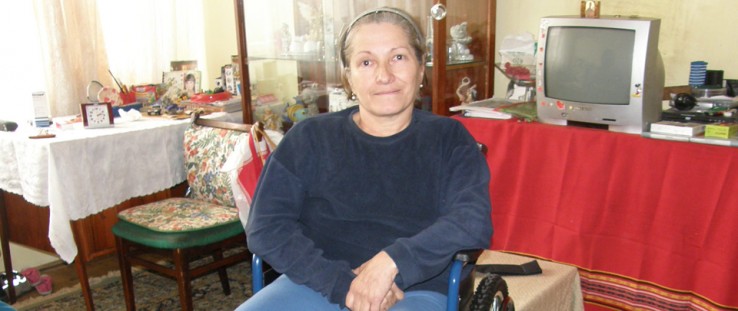 Valeria Gutu in her apartment
Courtesy of Motivation Romania Foundation
Valeria Gutu in her apartment
Courtesy of Motivation Romania Foundation
 Valeria Gutu in her apartment
Courtesy of Motivation Romania Foundation
Valeria Gutu in her apartment
Courtesy of Motivation Romania Foundation
Valeria Gutu suffered a debilitating stroke in 2011. She was homebound and spent all her time in bed until she met the team from the Motivation Romania Foundation (MRF).
After conducting an assessment in April 2012, MRF prescribed an appropriate wheelchair and explained how Gutu could request a subsidized wheelchair from the Health Insurance Agency (HIA). Because the county HIA has long waiting lists for wheelchairs, MRF donated a manual wheelchair to Gutu. It was life-changing—she could then get out of bed and start regaining her mobility.
However, there was still a major problem: Gutu, 57, lives in an apartment building with 15 steps leading to the entrance. So she still could not go in and out of her apartment without assistance.
But MRF also had a solution to this problem that would make Gutu’s building more wheelchair-friendly. MRF is a group that not only provides wheelchairs, but also studies the accessibility of buildings to wheelchair users by examining the exteriors, entrances, interiors and facilities of buildings.
Since 2009, MRF has run Wheels for Change, a USAID-funded program to provide services for wheelchair users in Romania. The main objective is to reduce the number of wheelchair users who are immobilized at home and to stimulate their participation in sports, community and society.
According to a 2010 study conducted by the think-tank Romanian Academic Society, between 42,000 and 78,000 people in the country need a wheelchair. The same study estimated that the public health system subsidizes only about 30 percent of the wheelchair need.
These figures may be underestimated as, according to the 2008 World Health Organization Report on Disability, about 1 percent of the world’s population suffers from reduced mobility or a motor disability. According to these estimates, in Romania there are more than 200,000 people with some type of congenital or acquired mobility disability.
MRF also is taking the first step in a long process to change infrastructure and make buildings accessible for wheelchair users through education and advocacy. Although legislation in Romania has some requirements related to accessibility of certain types of buildings, there is ample room for confusion and interpretation within this legislation. And, it is not properly enforced. Therefore, building owners have no incentives to make their spaces accessible.
“The lack of accessibility of public space is a major barrier to the participation in community life for people with disabilities in Romania,” says Alexandru Manaila. MRF’s accessibility coordinator. “On top of the physical barriers, people with disabilities in Romania also face barriers concerning their acceptance as equal partners in the society. Through our program, MRF encourages wheelchair users to get out from homes, we provide appropriate wheelchairs, and our peer group trainers, wheelchair users themselves, train them how to live an independent life.”
Unfortunately, the lack of wheelchair accessibility in public and private buildings such as hotels, restaurants, sport halls and individual homes, and lack of transportation are major constraints for people with disabilities. Steps taken so far at the national and local levels to improve accessibility have not garnered sufficient support.
“The MRF program tried to address accessibility from a different perspective, by certifying and promoting good examples of institutions and organizations that made their buildings accessible to wheelchair users in their communities,” adds Manaila.
Eleven regional MRF teams conduct assessments of public buildings and individual homes to determine the accessibility of the spaces for wheelchair users. The teams, which began home assessments in April 2012, work with architects to conduct assessments of public buildings.
“The program demonstrates that an accessible space brings many advantages to the whole community,” says Cristian Ispas, general director of MRF. “First, when an organization’s physical space becomes accessible, it enhances the public image of that organization. Second, the organization can attract new clients or beneficiaries from among individuals with reduced mobility.”
Wheels Mean Freedom
Gutu first met Andrei Venenciuc, MRF’s Neamt County team coordinator, because of a sticker on his windshield that read, “Do you need a wheelchair? We can help you.”
Gutu and her husband, Ion, live on a high floor of a 10-story building in the same neighborhood as Venenciuc and asked neighbors about the car’s owner.
For three days, Ion stood in the parking lot of the coordinator’s building between 5 and 6 p.m. hoping to meet him. Eventually, they did meet and Ion described his wife’s situation. Venenciuc arranged an assessment home visit within the next couple of days.
“We are very glad that we met Valeria and that we were able to provide her an appropriate wheelchair and the counseling she needed for making her building accessible,” says Venenciuc. “Fortunately, with support from her family and from the local authorities, she was able to put in practice our advice and to build a ramp that helps her get out from home every day.”
MRF tried to devise a simple solution to construct a ramp from the building entrance to the ground—a height of approximately 6 feet. The organization also advised Gutu and her husband on how to obtain the necessary approvals from the local authorities, because the ramp needed to be about 16 feet long to accommodate the grade from the ground to the entrance of the building. The couple eventually received clearance from local authorities to get a construction company to build the ramp, at the couple’s expense, which was completed in June 2012. There are no other people with disabilities in the building, but the ramp is used by elderly people who have reduced mobility.
Recently, Venenciuc has seen Gutu and her husband around the neighborhood, going for walks or to the market. They say hello every time they meet, and Gutu sends her regards to the entire MRF team who helped her regain her freedom of movement.
“I am very grateful to the motivation team for the wheelchair I received and for the advice on the ramp,” says Gutu. “Now I can go out every day, I can go to the market and for short walks in the small park in the neighborhood with my husband. It feels so good not having to lie all day in a bed, like I used to.”
One of MRF’s biggest accomplishments under Wheels of Change has been its Accessibility Map, launched in December 2012, which provides information on accessible buildings throughout Romania. It encourages building owners and administrators to make their buildings accessible to wheelchair users while promoting good practices in building renovation. Currently, the map includes more than 1,000 buildings, grouped into three categories: accessible, partially accessible and inaccessible.
Since the beginning of the program’s accessibility component in 2012, MRF has assessed more than 1,800 homes and 1,000 public buildings. Only about 23 percent of the public buildings and 18 percent of the wheelchair users’ homes are accessible. About half of the buildings and homes are inaccessible to wheelchair users. The rest are only partially accessible. Sustained efforts from both the public and private sectors are required to improve accessibility for wheelchair users and people with reduced mobility.
USAID’s mission in Romania closed in October 2007. The Wheels for Change program is funded through the Agency’s Bureau for Democracy, Conflict and Humanitarian Assistance.
Motivation Romania Foundation
The slogan “Make Freedom Accessible!” was the focus of the third edition of Gala for People with Disabilities organized in November 2012 by MRF in partnership with Active Watch-Media Monitoring Agency and TVR1, the main channel of Romanian public television. The “Open Gates” section of the gala recognizes companies and institutions that make their buildings accessible or make workplace adaptations for people with disabilities. An accessibility map website launched by MRF in 2012 is used as an advocacy tool for improving wheelchair accessibility in buildings of interest to the general public.
In September 2013, MRF organized a two-day workshop with the architecture faculty of the West University of Timisoara to familiarize students of architecture with practical aspects of accessibility. During the workshop, students learned what accessibility means, received information about the accessibility logo and the accessibility map, and did practical exercises, such as designing an accessible bathroom. The design was “tested” by a wheelchair user who provided his feedback.
Students also observed and assessed accessibility of various buildings in Timisoara with a wheelchair user and were required to identify solutions for improving accessibility. This initiative aimed to raise awareness and educate future specialists about the importance of accessibility from the practical perspective of a wheelchair user.
About 80 students attended the workshop and the feedback received from them was very encouraging. Educating young architects on accessibility issues is part of MRF’s long-term plans.
In August 2013, MRF began working with the National Authority for Tourism to develop an information campaign for tourism companies regarding accessibility issues. As a first step, MRF raised awareness among tourism companies on the potential of wheelchair users for the industry, including creation of a brochure for distribution among tourism companies at conferences and events.
Another brochure on the accessibility assessment process was created and distributed among institutions and organizations to raise awareness on how they can improve accessibility to wheelchair users in their buildings. MRF also worked with bloggers who posted information on accessible tourism and the accessibility map on their blogs.
MRF has organized more than 100 events dedicated to persons with mobility disabilities—specifically wheelchair users—such as seminars, conferences, training courses and active rehabilitation camps, where participants learn skills to be more independent in and outside their homes. Also, MRF independent living training programs encourage wheelchair users to get out from homes, to travel, to socialize, and to participate in cultural, sports and leisure activities in their communities. Unfortunately, currently these opportunities are very limited due to the lack of accessibility.







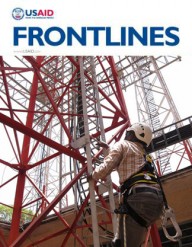

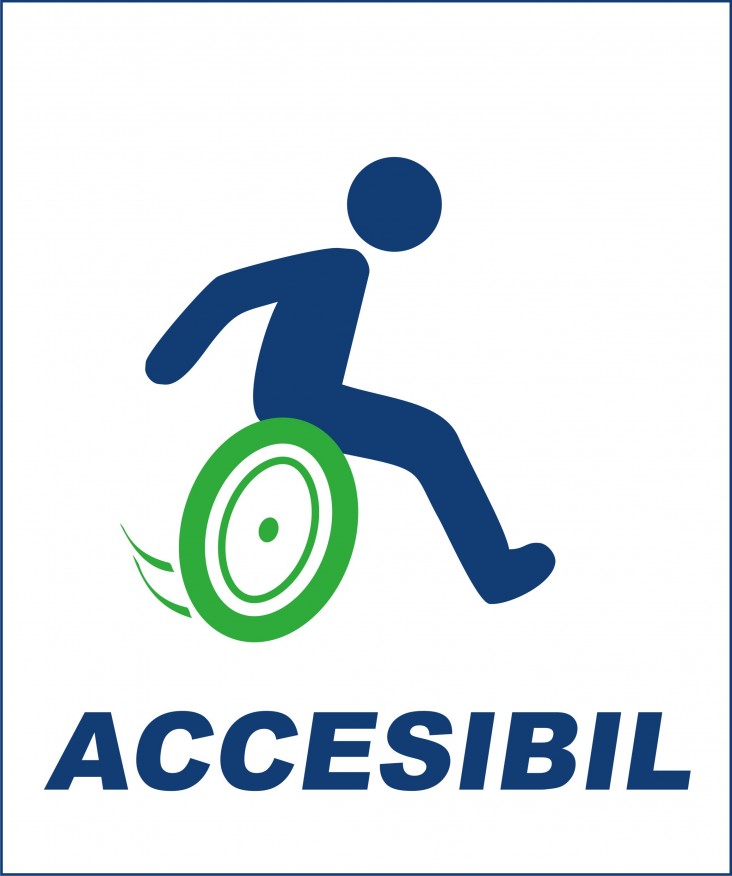
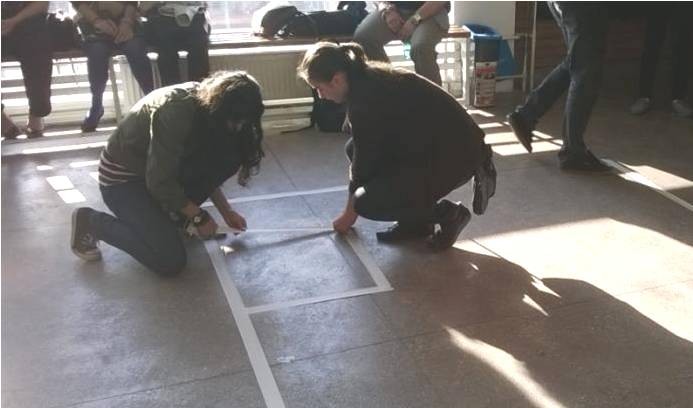
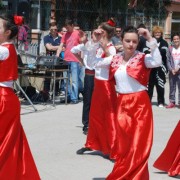
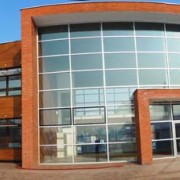
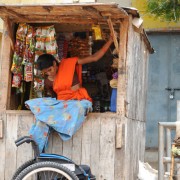
Comment
Make a general inquiry or suggest an improvement.